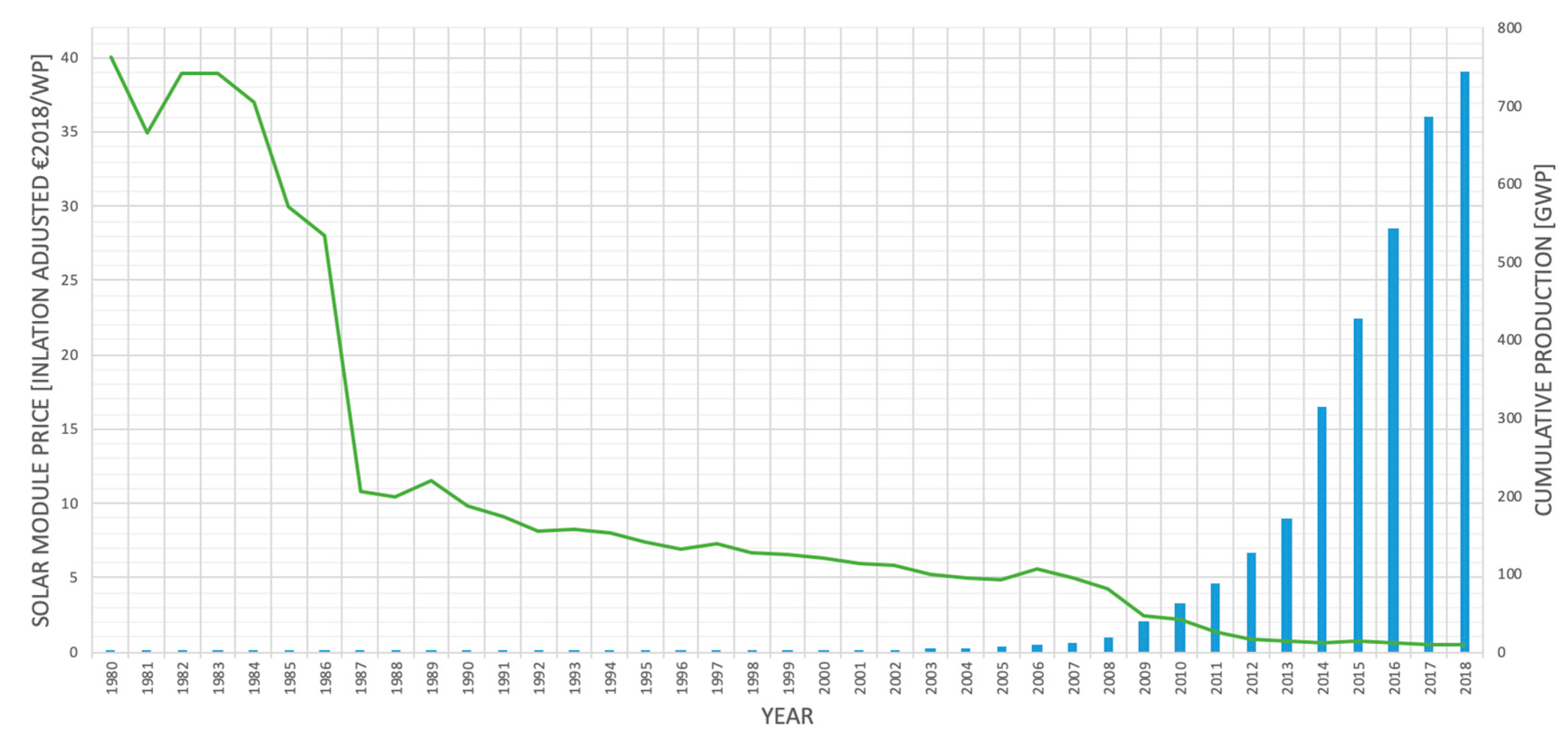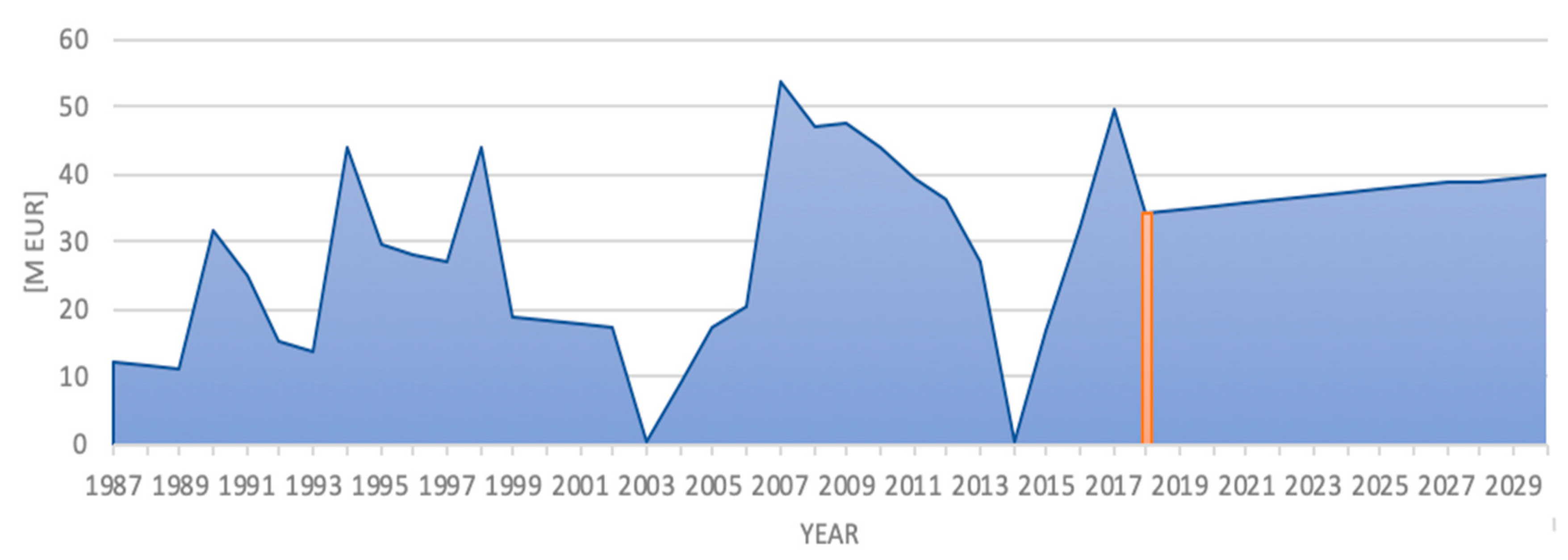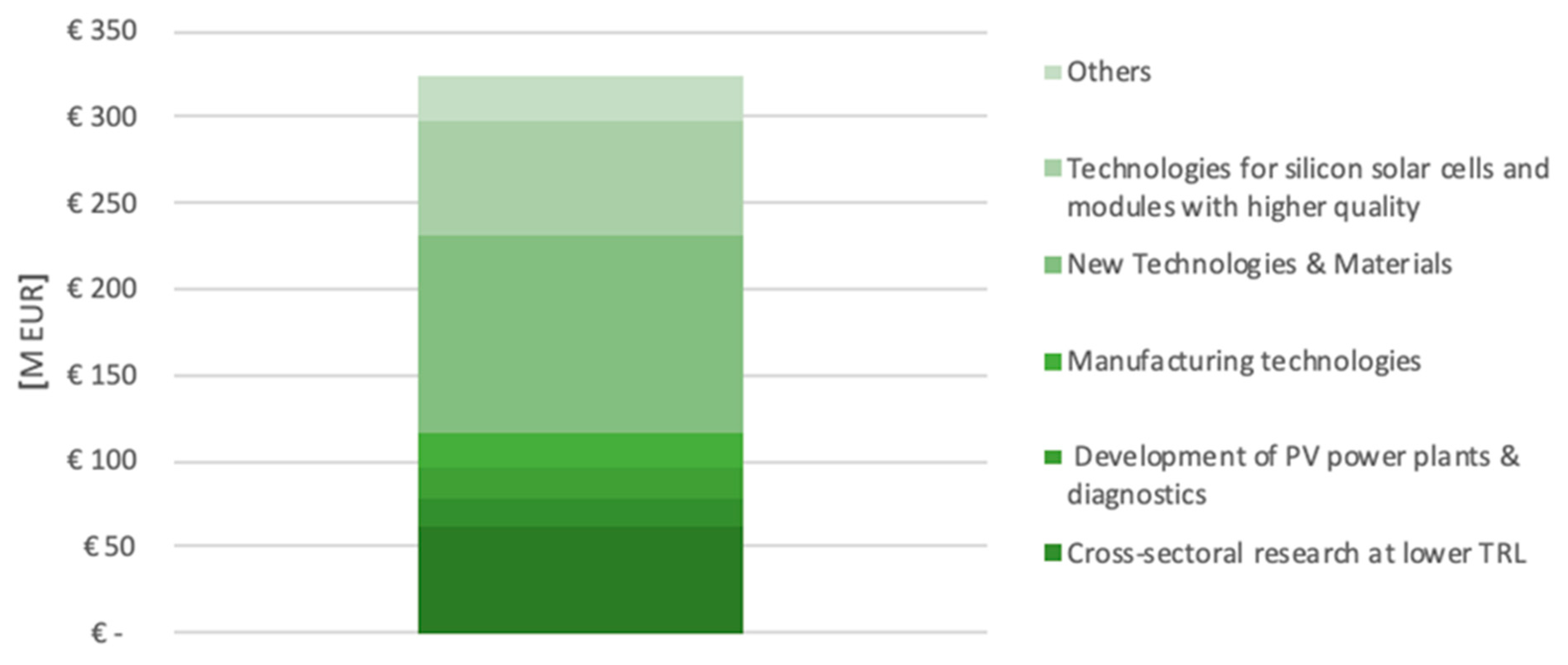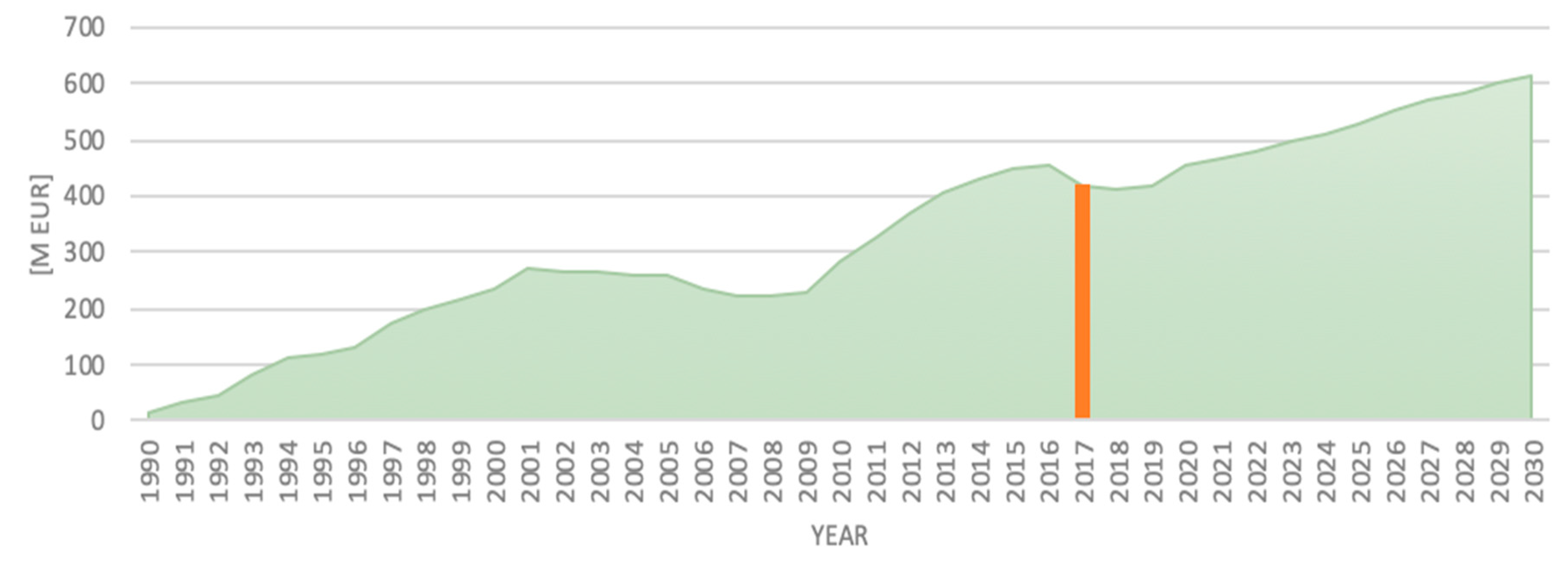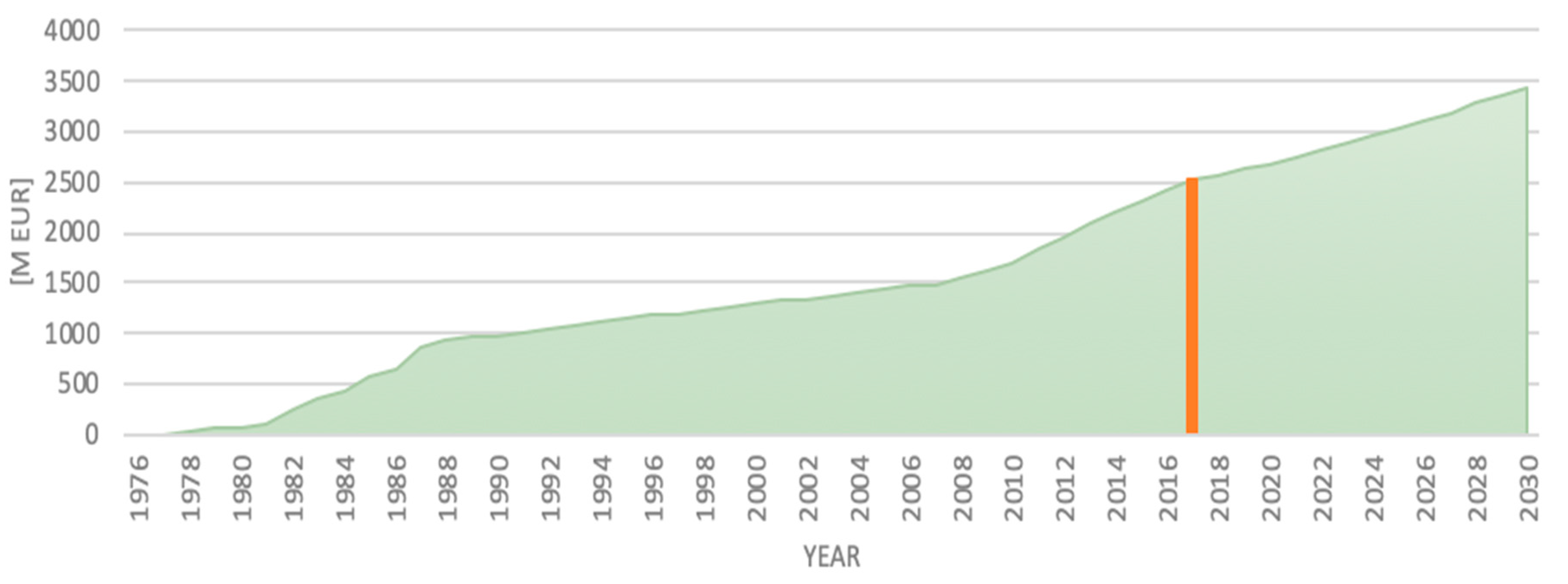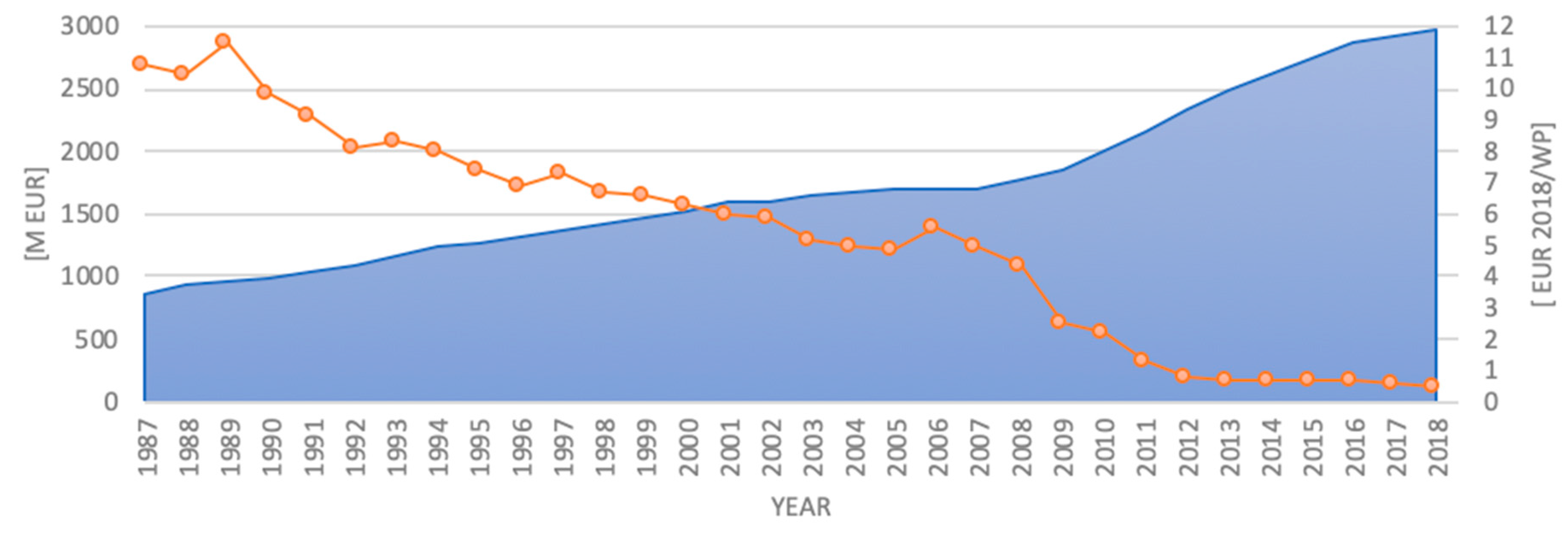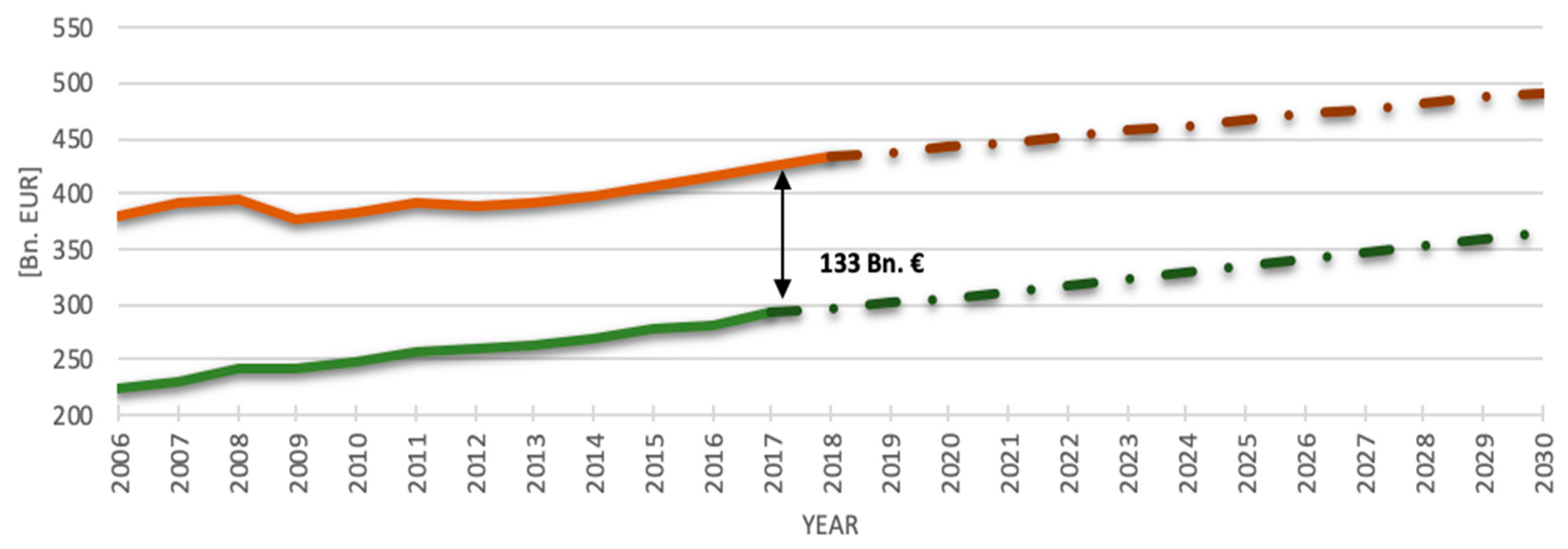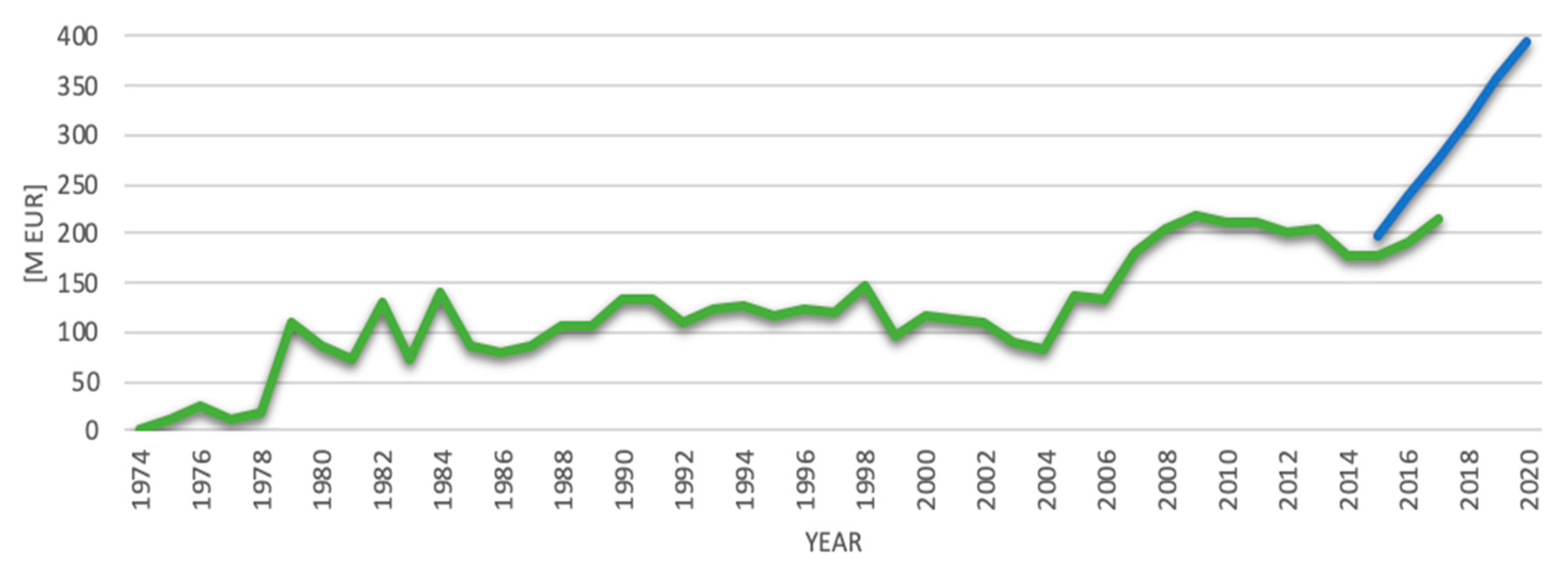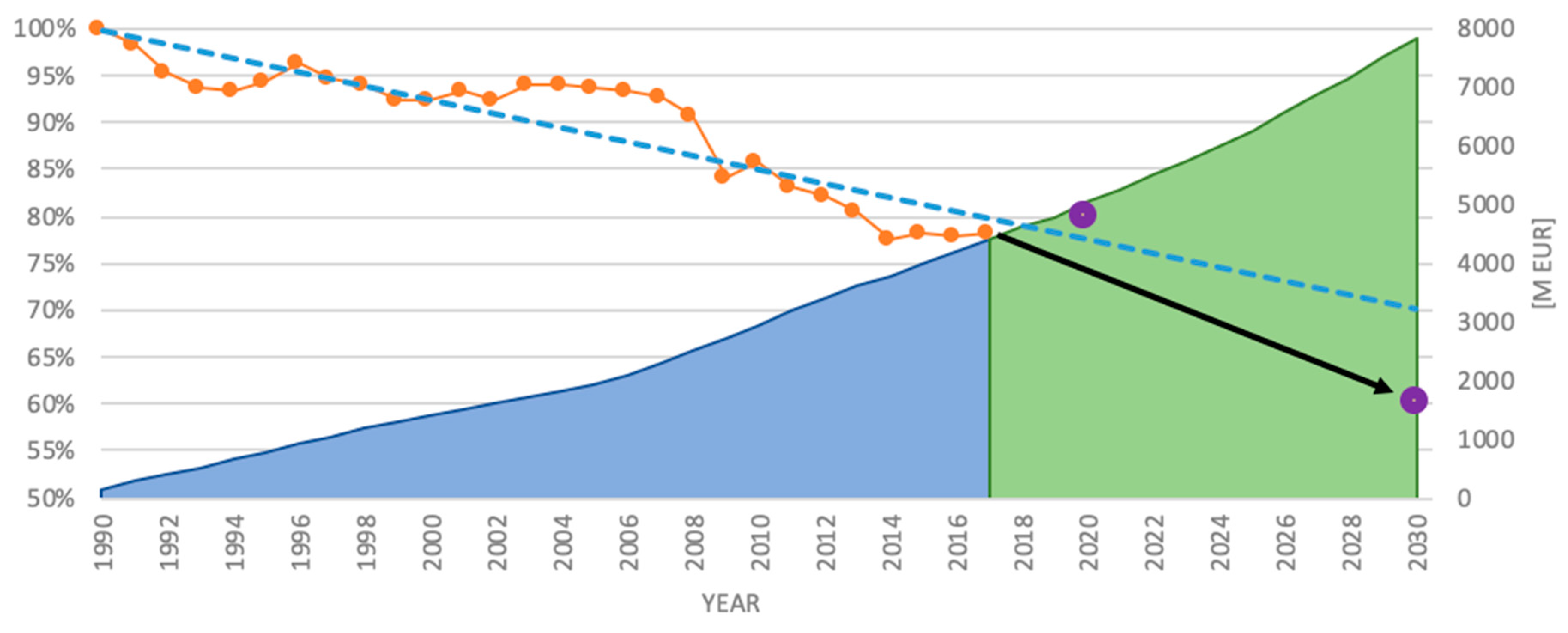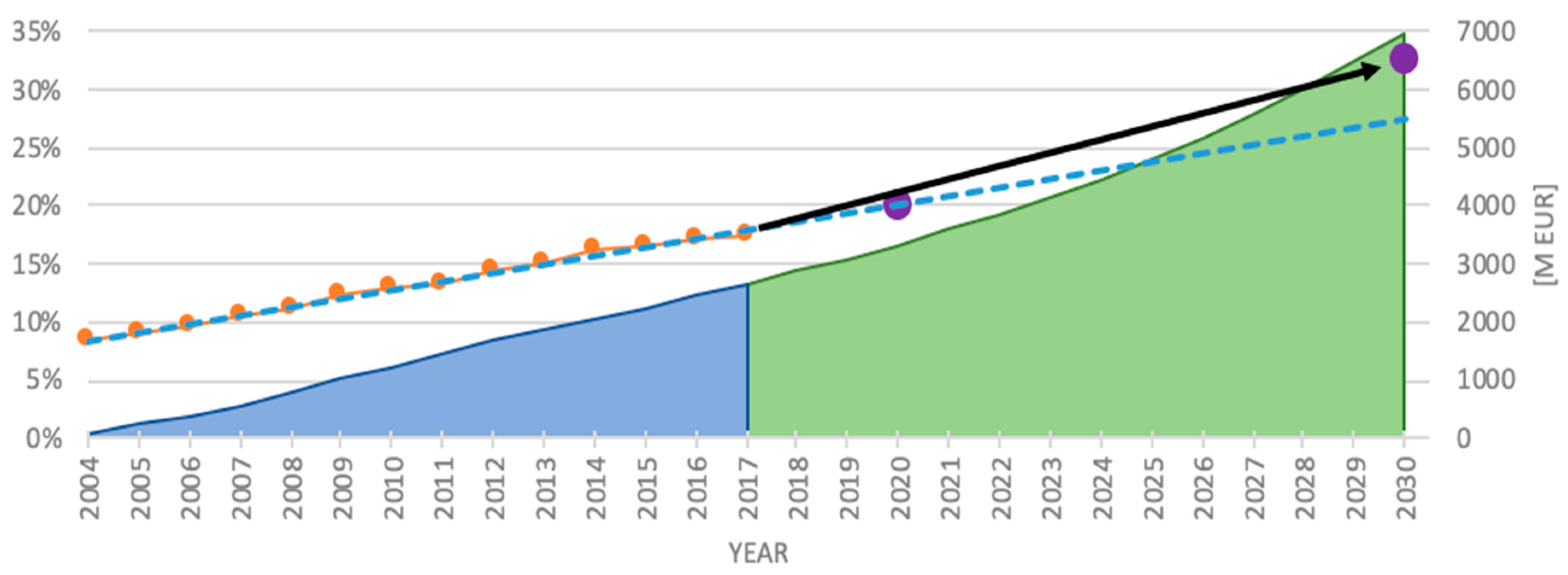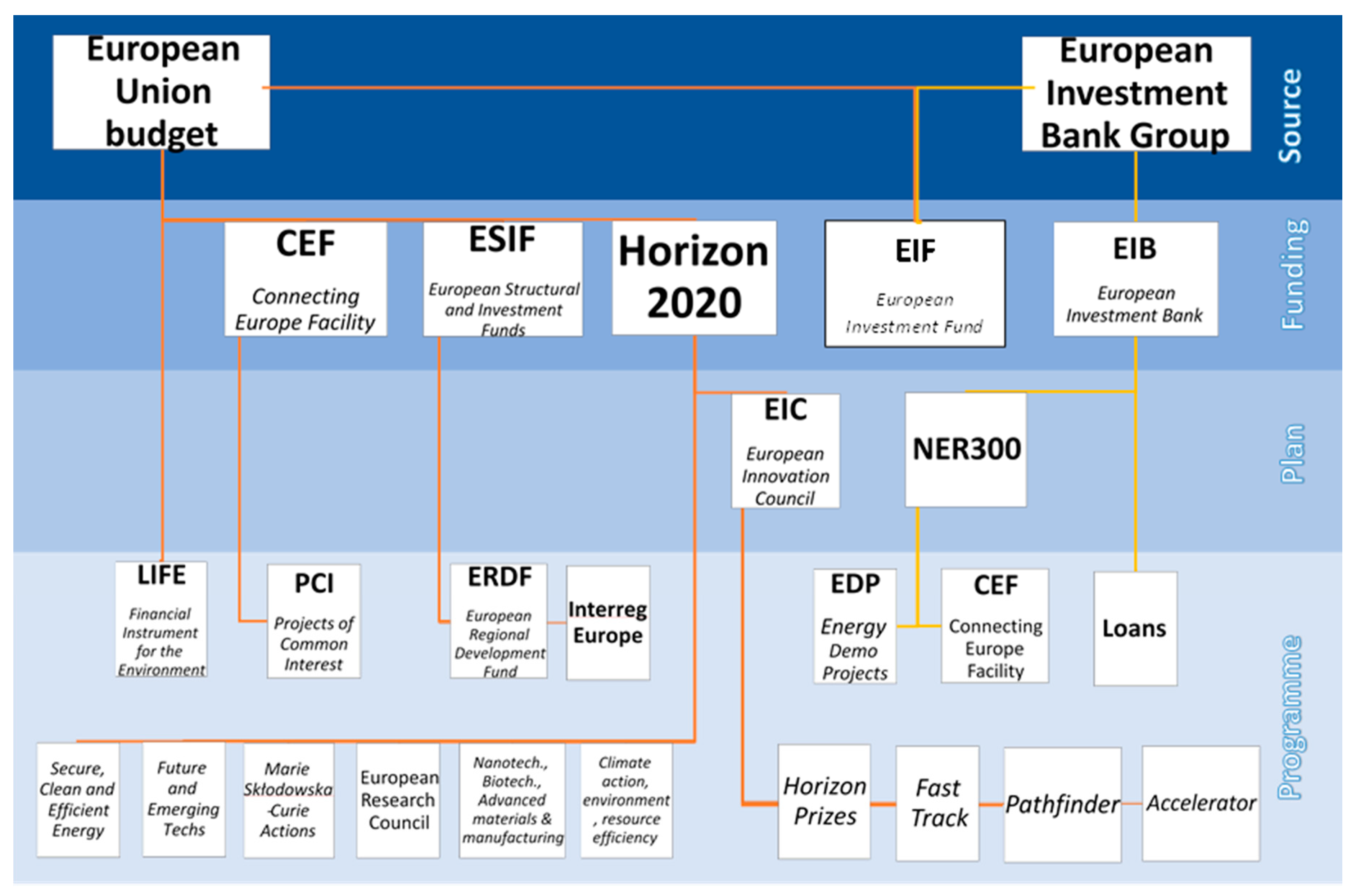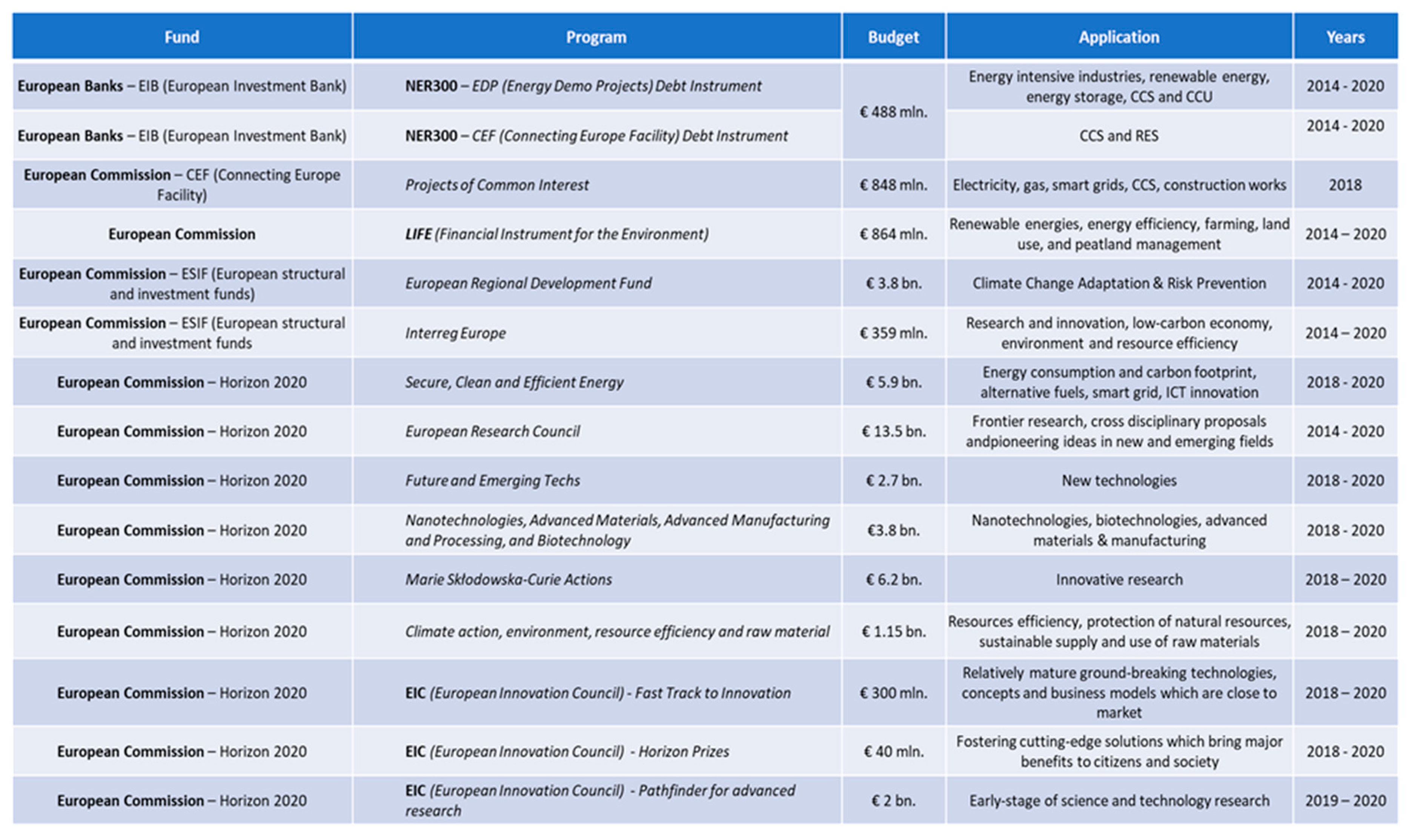1. Introduction
Since the industrial revolution, the use of fossil fuels boomed, becoming more and more widespread [
1]. Low prices and ample availability of natural resources fostered a period of spectacular economic growth after World War II. As the world became more globalized, the first big energy global crisis unfolded. The oil embargos imposed during the 1970s had an immediate upwards effect on oil prices around the world [
2]. As a consequence, many European countries that relied on imported energy commodities felt threatened. The term “energy security” started to be included in national energy policy conversations. Naturally, energy provision became a matter of national security and affected countries began working on solutions, exploring alternative plans. In addition, in the 1970s, the consciousness of environmental problems, including air pollution, oil slicks, and to some extent rising carbon dioxide levels in the atmosphere, and their potentially detrimental impact on human health, increased. It resulted in a range of multilateral environmental agreements and into the first European Environmental Action Program in 1973 [
3]. Up until that moment, photovoltaics (PV) had been an experimental technology mainly investigated for space exploration purposes [
4]. It eventually became the focus of intensive research and development (R&D) efforts, both in relation to issues of energy security as well as with regard to environmental and climate objectives, and after many decades of progress, it became one of the mainstream renewable energy electric generation systems we now know.
The development of an incipient technology is highly risky from the investment point of view, and not many companies will be ready to make such a choice. Public funding then becomes essential in this quest, by filling the gap from theory to reality and alluring private investment by ‘de-risking’ state-of-the-art technology [
5]. This phenomenon of private under-investment in early stages is not the only hurdle that needs to be overcome. Later on, at the commercialization stage, support mechanisms and suitable infrastructure have to be provided. When technology reaches more mature levels, changes in regulation are required that align with the increasing growth [
6]. The first solar cell was developed in 1883, and its evolution remained dormant until only the second half of the 20th century [
7]. It is not surprising that the needed technological advances were vast,
Figure 1 displays how much the price of solar modules had to drop before the installed capacity could start to grow in a significant way. In all those years the main driver enabling further deployment was R&D breakthroughs. An inflection point was reached in the 2000s, commercial installations, economies of scale, and favorable policies fast-tracked the adoption of the technology. An important element has also increasingly been the latent concern with global warming. Presently, PV can provide many advantageous characteristics compared to other energy sources whether they are traditional or alternative.
The countries concerning this study have embarked on the very ambitious path towards decarbonization, also agreeing to constant monitoring of the effectiveness of their actions [
9]. Having a clear picture of the state of affairs allows policymakers to propose legislation to steer energy production and consumption in the right direction. By 2050, the European Union (EU) aims to be climate-neutral and thus contribute to keeping global temperatures at levels settled according to international agreements [
10]. Its climate objectives are also an integrative part of its strategy for an Energy Union, launched in 2015 and which consists of five main, closely related dimensions, ranging from energy security and an integrated internal energy market to energy efficiency and climate action as well as research and innovation [
11]. Its research and innovation dimension explicitly aims at supporting the transition and the EU’s competitiveness with regard to clean and low carbon technology. The strategy emphasizes the importance of improving the effectiveness of its research programs, especially by combining EU and Member State efforts through remaining technology-neutral. This especially refers to the role of the EU’s research and innovation program Horizon 2020 in keeping investments steady and in ‘de-risking’ technology [
12]. It is also expected that the new regulation on Energy Union and climate action governance [
13] will contribute to increased collaboration between the European Commission (EC) and the EU Member States and across them, e.g., by systematically addressing public and private financing to research and innovation in the framework of national energy and climate plans (NECPs). At the same time, the stated objective is also the leveraging of private financing, although instruments such as Connecting Europe Facility, the European Structural and Investment Funds, or European Fund for Strategic Investments especially focus on energy infrastructure development and efficiency. According to the recently published EU Green Deal [
14], also the so far piloted Horizon 2020 European Innovation Council shall increasingly provide dedicated funding and equity investment to start-ups and small and medium-sized enterprises (SMEs) for further research and deployment of clean energy technologies. To achieve its goals, the EU also strongly relies on the support of the Strategic Energy Technology Plan (SET-Plan), which is defined as its “technology pillar for energy and climate policy” and “aims to accelerate the development and deployment of low carbon technologies” [
15]. The body responsible for leading this plan is called the Steering Group (SG) and is formed by representatives from the EU Member States (MS), Iceland, Norway, Turkey, and Switzerland [
16]. As of November 2017, the SG endorsed the “Implementation Plan for PV”, given it considers the technology being central to renewable energy sources (RES) deployment, which in turn is at the heart of the proposed new energy system. This plan considers R&D as an essential tool to bring costs down and achieve technological superiority for Europe. Innovation is the key to generating new knowledge, being essential to overcome problems in the energy sector [
17].
Considering the above, the following research questions were analyzed:
How much funding has been allocated overall to R&D for PV since 1974?
What is the share of private investment compared to public investment?
How does the knowledge stock supported by the overall funding and production price per kW relate?
How much funding is allocated for building integrated PV, cross-sectoral research, power plants and diagnostics, manufacturing technologies, new technologies, and materials or technologies for silicon solar cells?
Literature Review
The role of R&D is considered essential towards the effective deployment of RES, so keeping track of the performance of the investment is important to plan future allocations that help technology breakthroughs [
16,
18]. It is proposed that R&D is a key component for generating innovations (technological or otherwise) so it must be carefully tracked to make sure efforts are correctly aligned [
19]. Although the EU has historically set some defined targets concerning overall R&D spending compared to GDP, regarding renewable energy existing objectives only address R&D into clean technologies more generally, not necessarily related to PV, and are mainly based on multilateral agreements [
20]. It can be assumed that this is closely linked to the principle of technology neutrality adopted by the EU, to let the market select the most efficient technology and MS decide on the course of technological energy investment [
21]. It is expected that the final NECPs will provide further insights on the latter, although not necessarily on measurable targets, as an initial screening has shown. Not surprisingly, an information gap continues to exist also regarding the level of investment suggested to be attributed to PV. Some studies suggest that this needs to correspond to the same increase of R&D investment expected for renewable energy or clean technologies more generally, amounting to a two to five times higher need compared to existing levels [
22,
23]. These studies have also assessed the private investment in PV R&D (but have not done so exclusively for the region covered in this study) mainly through the use of financial statement analysis in combination with an analysis of patent filing. This is not a possibility for the area under this study, because of a lack of publicly traded companies. Moreover, there is no comprehensive research that encompasses all the public funding including the most recent Framework Programme, H2020. Finally, the relationship between private and public funding for PV is also vague. Literature shows a base of comparison for all RES [
12,
18,
24,
25], but again nothing specifically considering solely this industry.
R&D leads to innovation, which is the motor for continuous economic growth and development, by opening new markets and gain a competitive edge [
26,
27,
28]. Increased productivity fuels PV deployment when the sector starts to experience a slowdown [
29,
30]. Innovations can take the form of both regarding goods and services, but also with regard to the shape of business models or structures [
31]. Though Asian companies have grown at an amazing pace since the late 2000s, this is mainly because of the addition of factors of production, whereas EU companies have sunk in total production terms. These companies suffering from intense foreign competition should be financially supported to avoid the know-how they have amassed being lost [
32]. As PV is still at an earlier stage of development (compared to wind energy for example) the aim of R&D is fundamental to reduce costs, and as such represents a key objective of the SET-Plan [
33].
Public PV R&D should keep increasing as long as the EU keeps aiming to achieve its climate targets or raising them after successful completion. Both national and EU funding will grow because energy independence is being still actively pursued even though it has been on the political agenda ever since the 1973 energy crisis [
34]. The contribution of R&D is undeniable, but it has to be supported and complemented with the appropriate assistance of a common framework provided by organizations like the Energy Community, to ensure neighbor regions with high potential of PV generation and high gas reliance, are also integrated [
35].
To assess the level of private funding, information can be retrieved from companies’ financial statements; however, these are not necessarily straightforward sources. Although they provide exact figures for R&D expenses, they do not offer a detailed account of what those resources are used for. In these cases, a pro-rata mechanism is adopted, using publicly available patent filing data. This estimation sheds some light on otherwise rather obscure figures. To give some numbers for general comparison, it has been estimated that in 2011 in Europe overall private R&D accounted for about 62.82% of the overall investment into R&D [
18].
From a company’s point of view, stringent public R&D funding (meaning multiple conditions have to be met) can be extremely detrimental. If strict timetables and milestones are imposed, a business’s ability to navigate through difficult periods is severely impaired. Often, agreeing to a public grant entails agreeing to be able to cancel a project. A related issue is the crowding-out effect public funding might produce. By hoarding all the R&D initiatives, private funds could be lowered; however, if funds are granted through tax rebates, feed-in tariffs, or direct subsidies, internal efforts are augmented [
36]. It has even been suggested that larger firms benefit the most from this effect [
37] and that a smaller sized grant, which shares the risk with the business partner, minimizes a possible crowding-out effect [
38]. The full crowding-out effect produced by public funds is then generally rejected [
39].
The third research question mentions the knowledge stock (KS). This calculation has been used by Bointner et al. (2016) [
40], for further explanation of the method please see
Appendix A.
2. Materials and Methods
Naturally, the funding rationale from public and private sources diverges. The interaction between both actors is not the focus, nor is the financial market reasoning for capital budgeting, nor to measure the effectiveness of the investments or the effect of the high degree of uncertainty related to the investment [
41]. Both of these matters could be an interesting addition to create a broader picture for decisionmakers at the time of funding allocation. This study intended to produce a figure for R&D expenditure that can be compared to past and future ones.
To allow an in-depth study of PV R&D funding, a comprehensive analysis of many different sources addressing the issue had to be performed. On the one hand, national budgets allocations from EU MS, Norway, and Turkey (these specific countries are considered because they are members of the SET-Plan PV Temporary Working Group [
42]), were compiled using one single database (from the IEA [
43]), to address the research questions. On the other hand, funding provided by the EU budget is spread across multiple programs [
44]. Business data show a completely different picture, as there is no dedicated overall source of information. The level of disclosure of information more or less depends on the goodwill of each company, so a case-by-case situation was encountered.
2.1. Public Sector
An exhaustive inquiry of all available funding (see
Appendix B) showed that the total resources originate from two main sources: the national budget of individual countries and the EU budget. Using the International Energy Agency’s (IEA) statistics data browser [
45], it was possible to gather the necessary information for individual EU MS, Norway, and Turkey. Via their service hub the “Detailed country RD&D budgets” report containing expenditures at the national level provided by each country was used. Not all EU MS are affiliated to the IEA, and the implications of this gap of information are discussed in
Section 3.5 “Discussion of the method”. From the report, only the category “312 Photovoltaics” was considered. The appropriate values were provided starting in 1974 and are expressed in real terms at 2018 values, so no inflationary adjustments were needed. There were two other categories (319 “Unallocated solar energy” and 39 “Unallocated renewable energy sources”) that could also contain PV investments, but these were not taken into consideration because they were bundled together as “Unallocated” with other solar technologies. Finally, since the data were disclosed by country, it was summed up to a regional total, referring to all those countries being studied.
For data regarding EU funding, the Community Research and Development Information Service (CORDIS) was used [
46]. There are many EU programs providing resources for PV R&D, but after careful investigation, it was revealed that approximately 85% (see
Appendix C) are allocated in the framework of the EU’s leading R&D investment arm, the Framework Programs (FPs) for Research and Technological Development. These programs have historically provided the largest amount of resources [
40]. Successive FPs have been operating since 1984, with increasing budgets and of short duration. The current ongoing (2014–2020) FP is called Horizon 2020 (H2020) and will be soon replaced by Horizon Europe (2021–2027). The data provided were given in nominal values, so an inflationary adjustment was performed to make a consistent comparison through time. Using 2018 as the reference year, time-based annual inflation rates established by the International Monetary Fund [
47] were used to construct a cumulative compounded inflation table and transform the values to real ones. Furthermore, during the first five FPs, the category “Photovoltaics” was shown as grouped in total, so the exact yearly disbursements were unclear. To show a more gradual result, these totals were divided for the number of years the FPs lasted and assigned equally. From 2004 onwards, the exact yearly allocation was provided, so no adjustments were needed. For H2020, as it is still running, a project list was given with no general groupings. This means that all the existing entries had to be sorted. To do so, filters were applied, which looked for specific keywords in the projects’ abstract description concerning PV. A secondary screening was later performed to refine the search and group each project according to one of the six categories proposed by the Implementation Plan [
16]. This time each relevant abstract was read and manually allotted to the corresponding category (an “Others” category was added for those projects that did not fall into any of these).
2.2. Private Sector
As stated by both the EC [
48] and the IEA [
49], access to business data for PV R&D is limited. The first attempt of a bottom-up approach, by collecting information from individual companies using a questionnaire, was made; however, little feedback was provided, and the results were very poor. Considering the classification of the PV supply chain according to three levels by the Organization for Economic Co-operation and Development (OECD) [
50], it can be assumed that most R&D activities would take place at the manufacturing/midstream level rather than at the processing of the raw materials/upstream or power generation/downstream level. Two factors combine to support this notion. Firstly, PV panels are, on average, the largest portion of the cost in a commercial installation [
51], and secondly, the activity categorization done for H2020 projects shows that around 56% of funding is destined for the improvement of the efficiency of panels (
Section 3.2 “European Union”). Following this assumption, PV manufacturers seem central for R&D, so a list of 36 EU solar cells and panels manufacturers was developed. From this analysis, it became clear that there are no big pure-play PV companies left that are largely owned by EU capitals. Almost all of the companies identified are subsidiaries of larger corporations or privately held, which made access to data difficult. As opposed to publicly listed companies, private ones have no mandatory requirements to disclose their financial statements (which is always the main source of a company’s information on public access); however, even if large corporations report their statements, R&D expenses are usually quite obscure and not further specified, as reviewed by van Beeck et al. [
52], and Jacquier-Roux and Bourgeois [
53]. This is why studies such as the latter have tried to estimate concrete values by making a comparison of how many patents had been filed. This method was not considered useful for the simple reason that no data are available from most of the identified companies. When contacted, they refrained from providing any type of indication from their operations, to protect what they considered material information regarding the strategic future of the business. To overcome this information gap, it was decided to apply a hybrid method, merging a bottom–up/top–down approach. It was found that EurObserv’ER [
54] compiles a barometer for total turnover from companies in the PV sector. The calculated average ratio of R&D expenses of the total turnover of the few companies that provided relevant information in the aforementioned list was combined with the total turnover estimations for 2015, 2016, and 2017 provided by the barometer. This resulted in an approximate value of private investment in PV R&D in the EU over three years (Turkey can be safely excluded due to their small contributions to R&D in general at the national level and particularly because of the low investment level in the private sector [
17]). The last step included a cross-check with studies on private R&D investment in RES as a rough corroboration for the numbers produced.
2.3. Forecasted Scenarios
Considering the energy and climate objectives the EU has set for itself, three proposed scenarios are considered:
An increment of annual R&D investment to the equivalent of 3% of gross domestic product (GDP).
Mission Innovation: starting in 2015, doubling PV R&D funding until 2020.
Reaching a RES share of final energy consumption of 20% (2020) and 32% (2030). Also, a reduction of Greenhouse Gas (GHG) emissions from 1990 levels of 20% (2020) and 40% (2030).
The scenarios considered GDP forecasts, state of PV deployment, and the potential of innovative PV systems. The business as usual (BAU) methodology was used, meaning that the ongoing trends were expected to continue its current performance in the future. To do so, a linear regression was calculated, for which historic data were used to build a predictive path—see Equation (1).
The rule of three was used to linearly predict the amount of funding needed for the projections. To reach these targets, the level of accumulated PV R&D will have to be increased proportionately—see Equation (2).
: Known variable.
: Known variable.
: Known variable.
Unknown value.
To calculate the regression line to forecast GDP values on the first advanced scenario, instead of using single year data from past periods, a three-year moving average was used instead. The reason for doing so was to stabilize the possible dispersion of data, as GDP is a very large and complex indicator.
2.4. Knowledge Stock
Bointner et al. 2016 [
34] define knowledge stock as the cumulative economical value of knowledge. The concept is also supported by Kobos et al. 2006 [
55] and Klaassen et al. 2005 [
56], both of whom provide an overview of the subject. It is an optimal way to indicate the necessary funding levels towards achieving specific goals. The method also provides an effective solution to counteract the effect of large fluctuations throughout the years, whilst considering the depreciation of knowledge as time goes by and introducing the positive effect other sectors have—see Equation (3).
Spillover.
δ: Depreciation.
Time period.
X: Time lag.
Spillover (
) is one of the first terms and has a supplementary effect on KS. External sources (e.g., the glass industry) of knowledge provide an added value at no cost, and as such represent a collateral consequence of their innovations. A value of 35% was assumed, based on a technical study regarding energy spillovers of clean technologies conducted by the EC [
57]. Depreciation (δ) is another key term, and has a negative effect on the total value, as it means that every year a portion of the previously gained knowledge is lost or else becomes useless. A factor of 10% was used, based on a study done by Bointner (2014) [
58]. The third important variable was time lag (X), meaning that, from the inception of a research study until it produces a result, there was a delay. In this case, a value of three years was assumed since this is the average duration of an H2020 project. Starting in 1974 with only IEA data, from 1987 onwards EU data from FPs were added.
2.5. Discussion of the Method
It was previously mentioned that not all EU MS are also part of the IEA (Norway and Turkey are members). This limitation was important because it means that not all relevant R&D funding was taken into consideration. It particularly concerns MS such as Bulgaria, Croatia, Cyprus, Latvia, Lithuania, Malta, Romania, and Slovenia. Nevertheless, Wiesenthal et al. 2012 [
59] confirm that IEA member countries account for 99% of the total funding, so it was safe to disregard the missing countries from the analysis. Another issue was that some of the countries that provide information to the IEA were not always able to provide a concise breakdown of the allocation of funds according to technology type, generating a gap in data [
18]. In this case, the blank entries were not compensated by the use of gap-filling nor other methods.
Another issue that arises from the use of this data was the likelihood of incurring “double-counting” funds originating from the same source. As the EC allocates the available resources to individuals, companies, or other entities, there was a possibility that the IEA also includes these in the MS national allocations. There is a very explicit explanation on a separate document provided by the IEA [
43], where it is stated that for the countries under consideration only funding given by federal government institutions is provided, so there was a limited chance of mixing the origin.
An important difference when comparing EU data to national data was that the latter started to be accounted for since 1974, whereas the FPs involving PV only kicked-off in 1987, creating a 13-year time lag between the datasets. In addition, the EU’s changing MS composition needs to be considered: since 1952 the amount of MS has increased considerably (see
Appendix D). By 2019 the bloc counts 28 MS (most recently, the UK has invoked Article 50 of the treaty of the EU, which will conclude with the withdrawal from the 46-year-old partnership), when in 1990 only 12 countries formed the European community. So, a comparison of the EU funding, even if it originates from the same source is not entirely equal across time, because not only the FPs budget increased, but also the amount of receiving parties did.
Concerning the private sector funding, it can be said that the main set back is the general lack of data. Like mentioned before, businesses have little incentives to share any kind of information regarding their state of affairs. The proposed solution was the application of a top–down/bottom–up approach hybrid using an average ratio to represent the EU manufacturing sector’s commitment to R&D. This was an approximate estimation and was done with the very few available sources of information. Nevertheless, since first-hand data were not available at the moment, the results are a fair estimate of the PV R&D situation in the concerned region. Different from other studies [
24,
28,
59,
60] carried-out at a global scale and as such with more information at hand, in this case, the use of patents as a pro-rata proxy was not considered sufficiently useful.
2.6. Limits of the Study
By using the IEA [
45] as a source of national funding data, not all the investment might be represented. Each country reports its own figures and they differ in methodology, for example, Germany’s excludes expenditures from regional governments.
Regarding data reported by CORDIS, it might be that not all funding could be assessed because projects might not be accurately categorized. If a project’s budget was sourced from a non-energy budget, even though the aim was PV R&D, it would not have been accounted for.
The strong competition coming from all over the world has put a considerable amount of pressure for the PV industry in Europe. Companies have been subject to bankruptcies and takeovers very frequently, with the result of very few publicly traded companies left. Other studies on PV R&D have benefitted from publicly available financial statements to guide their research. The lack of access to the same information represents a substantial limitation, that is why an indirect source (EurObserv’ER [
54]) was used to produce an estimation instead. Nevertheless, an attempt was done to directly source data from a number of these companies. The result was very unsatisfactory, firstly because of the low rate of answers, and secondly, because the figures provided by the respondents were extremely high and were thus classified as unrepresentative of the real situation.
When addressing the forecasted scenarios, it was assumed that R&D has an impact on the future achievement of certain EU goals. Even though there was a relationship between there variables, it was not a direct one, and it was not possible to ascertain the exact effect. Despite this constraint, these scenarios may be nevertheless used as an indication of the evolution of R&D since innovation will be a key component to meet these ambitious goals.
4. Discussion and Conclusions
R&D is crucial for the generation of innovations, which in turn nourishes economic and social growth. PV R&D funding has been highly sensitive to diverse world events that have an impact on the energy markets, as alternative means of production are sought. The EU MS, Norway, and Turkey all depend on the trade of energy commodities, and for a long time they have trusted their allies to provide those resources that are not obtainable locally. PV offers the unique characteristic of fixing the problem of natural resource scarcity by making use of an energy source available to all. Additionally, PV is a zero-emission electricity producer that uses vastly available resources as raw materials and can be adapted for both commercial and residential use. There are many restrictions to its use, nevertheless, the technology has an enormous potential still to be unleashed. Investing in R&D is the most effective way to do so. For the last 50 years, continuous innovations have been ensuing, enabling the acceleration of PV adoption.
The results show that there is a strong interlinkage among PV R&D investment and socio-economic transformations. When war broke out in the Middle East in the 1970s, it had unforeseen effects on oil prices, and a change of paradigm occurred with these events. Developed countries with no supply of their own suffered from the lack of energy security.
As the EU embarks in the very complex endeavor of decarbonizing its economy, it became clear that considerable efforts had to be made to comply with the deadlines that were set. The first targets for energy and climate have a deadline in 2020. So far, the efforts made to meet them seem sufficient; however, when the next deadline (2030) is considered, the ongoing trend indicates that a substantial increment of efforts is needed, and that includes PV R&D. The EU has the advantage of having the necessary expertise and financial backing to make these goals a reality.
External shocks have created various investment waves in PV R&D. No factors have been identified that suggest this would change; therefore, is quite important for the EU’s long vision energy plans, to consider the importance of sustainable and self-produced energy sources. To promote this, innovation is essential. It cannot be ignored that technological breakthroughs take time to be developed. Another positive factor that is worth exploiting is the long-running history of EU dominance in the production of scientific content. The KS approach shows an apparent continuous growth of total PV R&D that spans through decades, and the likely association with the growth of installed capacity. The accumulation of innovation has helped lead the price drop that took place in the same period. The innovation that was accomplished, mainly aimed at improving the efficiency levels of solar modules but other areas have also made great leaps, like a more diverse use of raw materials and manufacturing methods. A reverse in the current trend would have a major impact on the development of PV, putting at risk the successful completion of the vision the EU has for the energy industry.
Considering the national PV R&D funding, it has been observed that the countries allocation is highly concentrated. Only four countries have provided 83% of the total accumulated values (Germany, Italy, France, and The Netherlands). How to foster collaboration across the Member States to share information on PV R&D breakthroughs is thus to be taken carefully into consideration when further implementing the EU’s regulation on the Energy Union’s governance. In addition, the results also need to be compared to the objectives and the analytical basis provided in the framework of the submitted NECPs. These shall be subject to further scrutiny in up-coming research.
On average, since 1987 national funding has exceeded EU funding by nearly a factor of five, making evident the disparity between these two sources. Another clear difference is the variability of the flows. National budgets tend to fluctuate less, showing more consistency and stability over the years. The exact opposite happens for the EU funding, sharp changes year to year are common so a general trend is less clear. This is partly explained by the nature of the FPs. This indicates that existing EU research and innovation policy might have failed in delivering what was promised as a steady investment into clean and low-carbon technology. How to level the constant fluctuations linked to the way capital is allocated depending on project durations and multi-annual budget negotiations, and whether a smaller but more widespread low-cost funding might be more effective are considered important aspects to discuss concerning upcoming research programs such as Horizon Europe.
As these programs span several years, they tend to keep the same objectives for allocating funds to the same areas of funding for the duration of the program. When a new program is launched, those views might change, or have a different focus, which in turn affects how the investment performs every year. From the analysis of H2020 projects, it is seen that the areas related to the improvement of efficiency levels have been awarded approximately 56% of the funding. This gives a clear indication that the future of innovation will be mainly delivered in the form of better solar modules with augmented performance and not so much in other areas. It also means that there is still room for further technological improvements and that theoretical ceilings can be pushed even farther. The more effective way to address any technical constraint is through R&D investment. If a comprehensive and integral methodology is implemented on knowledge transfer, considering open source promotion policies and joint initiatives is implemented, a more efficient allocation of resources could be obtained and double-research avoided.
The private funding topic proved to be a problematic area for this study. Companies were very reserved when contacted and mostly refrained from disclosing anything regarding their R&D department. In their eyes, the activities carried out by this department have a material impact on the business strategy. After an unsuccessful attempt to do a bottom–up estimation, the methodology chosen followed a more general approach. After choosing 3.26% as the reference ratio for the average turnover to R&D, it was estimated that in 2017 the private funds totaled approximately 62.82%, and that public funds took 37.18% of the total PV R&D funding.
With the information at hand, no other alternative calculation could be considered. This analysis proves that public information is easily accessible as opposed to the private sector’s one, which remains behind an impregnable veil. These figures serve as a benchmark for any study that does a follow-up on the matter. As the spending performance is evolving constantly, further research seems necessary to keep monitoring on the field. Either providing future guidance on reporting private R&D spending in the framework of the NECPs or on non-financial reporting on climate-related information according to EU Directive 2014/95 could be initial ways forward to increase the robustness of the data basis.
The following limitations have to be considered when interpreting the results of the analysis. First, it is not possible to totally exclude an overlap between EU and national R&D funding. IEA data result from individual country reporting and each country has considered different aspects when providing their figures. Furthermore, data concerning the private PV sector has proven to be extremely challenging to compile. The estimated results were calculated with the few sources at disposal. As such, the private PV R&D funding data includes many uncertainties and should be subject to further research. Moreover, the outlook of the different scenarios has been calculated based on historical values. It is not possible to generate exact forecasts, also due to the impossibility to predict the occurrence of intervening variables. Thus, it has been simply assumed that the current trend will be on-going; however, unexpected events (such as the COVID-19 pandemic in 2020) can be the cause of major economic disruptions that alter objectives and occurring operations, potentially also affecting public and private R&D funding more generally and for PV more specifically.
Public support to R&D is necessary, especially to engage in highly experimental areas of work. The cluster of private companies that were considered shares the same central threat from low-priced imports, which in turn puts enormous pressure on profit margins. Under this scenario, engaging in agreements with research centers and universities could prove an interesting workaround to keep costs down, but at the same time not neglecting the necessary efforts in the area.
The situation for these companies has changed a lot in the last 20 years, however, the fact that the European PV manufacturing industry has an extensive trajectory and experience is the key to keep competing. The remaining companies are spread through the region, fragmented, and highly specialized. Competing with low price manufacturers will not be a sustainable tactic, but an increment of the added value to the product being sold will be a highly effective way to set themselves apart from the rest. To achieve this, innovation is the key component. The more differentiation that can be poured into new solutions will give struggling companies a competitive edge. R&D investment is the general enabler of this tactic, and a sort of insurance any company can get to make sure its operations continue year after year.



